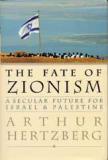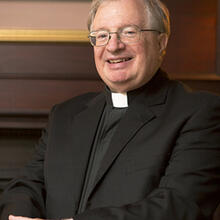Elusive Peace
With the approval of a new Palestinian cabinet, led by Mohammed Qureia, the publication of two model peace plans by leading Israeli and Palestinian peace activists and the recommendation by four former heads of Israeli internal security (Shin Beth) of a unilateral withdrawal by Israel from the West Bank, the cloud of despair that had fallen on Israel and the Palestinian territories this summer has begun to lift. After so many years and so many failures, making peace in the Middle East requires the introduction of new factors that can change the dynamics of the Israeli-Palestinian conflict. Israelis seem to understand this, and so do an increasing number of American Jews.
While the American Israel Political Action Committee (AIPAC) has been an ascendant force in U.S. politics, defending Israel and preventing U.S. accommodation with the Palestinians, the broader American Jewish community has been a rich source of alternative ideas for the future of Israel and Palestine. From the Israel Peace Forum to Americans for Peace Now, Tikkun and Jews for Peace in Palestine, American Jews are searching for a way through the morass that is Israel/Palestine.
Rabbi Arthur Hertzberg is an esteemed Jewish intellectual and an advocate and historian of Zionism. Like so many others, he shows frustration over the elusiveness of peace in the Middle East. The Fate of Zionism, his newest work, finds in religious extremism, particularly on the Israeli right, the key obstacle that more than ever before prevents making peace between Israelis and Palestinians. Although he never loses an opportunity to fault Arab intransigence and the fecklessness of Western liberals, his real concern is Jewish extremism, which, together with Islamic militancy, threatens the Zionist dream of a Jewish homeland where Jews can be a nation like any other. “The greatest contribution religious faith can make to peace between Jews and Arabs,” he says, “is to get out of the equation.”
The fundamental flaw in Hertzberg’s argument is that ultra-Orthodox leaders in the settlement movement are relative newcomers to Israeli politics. True, the religious parties have long had disproportionate influence over Israel’s coalition governments, and the ultra-Orthodox have given a boost to hard-liners in the Israeli settlement movement. But the real power in Israeli politics today is the Likud Party, the heir of Ze’ev Jabotinsky and Revisionist Zionism.
Revisionism, a militant variety of secular Zionism, believed the land (Eretz Israel) could be won and held only by force. In a speech he gave in 1923, “The Iron Wall,” Zabotinsky articulated a maximalist agenda for the Zionist cause: the territorial integrity of Israel, embracing all of Mandate Palestine, and the Jewish right to sovereignty over the whole territory. Jabotinsky’s strategy for obtaining this end was “to erect an iron wall of Jewish military force” against Palestinian resistance to Jewish colonization of (Mandate) Palestine.
Jabotinsky’s political descendants are a “Who’s Who” of Israeli politics. They include Menachem Begin, Yitzak Shamir, Binyimin Netanyahu and Ariel Sharon, the men who have dominated Israeli politics for the last quarter-century. Indeed, in an op-ed piece in The International Herald Tribune on Sept. 24, the Oxford professor Ariel Shlaimi named Ariel Sharon, rather than Yasir Arafat, as the principal obstacle to peace in the Holy Land. Oddly, neither Likud, the party Mr. Sharon leads, nor its Revisionist predecessors appear at all in Hertzberg’s narrative of Zionism.
The real obstacle on the Israeli side today is not religion, but Revisionist politics. If the “iron wall,” as Oxford historian Avi Shlaimi has demonstrated, has been the undeclared, but documentable, policy toward the Palestinians in successive Israeli governments, then what is to be done? Hertzberg’s proposal is that the United States must force both sides to make difficult accommodations. The Israelis must be induced to end “creeping annexation” of the West Bank and to abandon their settlements; the Palestinians must be persuaded to end the violence of militant groups. In both cases, the U.S. leverage would be economic.
Hertzberg boldly violates the taboo on using U.S. aid to pressure Israel, urging the United States to condition aid on dismantling the settlements, something the Bush administration is already exploring. He would also use the promise of U.S. aid to return hope to the Palestinian people and would apply financial and police pressure on weapon suppliers to defuse the armed Palestinian resistance. All these remedies aim at lowering the heat in the Israeli-Palestinian relationship, opening the possibilities for peacemaking later. None is directed immediately at the author’s alleged target: religious extremism on either side. What he has offered is a renewed, modest vision of Zionism in place of the expansionist militancy of Likud and the settler movement.
Rabbi Michael Lerner, who edits Tikkun, the instructive and inspiring Jewish journal on spirituality and politics, and leads the Tikkun Community, a peace advocacy group, offers an alternative based on grass-roots, interfaith advocacy for peace. While he may be best known—and belittled—by his critics as an occasional spiritual adviser to Hilary Rodham Clinton and proponent in the mid-90’s of “the politics of meaning,” he may be the most serious and accomplished religious activist at work in the United States today. Lerner is also a courageous man. For example: Lerner endured concerted attacks from fellow Jews because, after the outbreak of the al-Aqsa intifada in 2000, he had shown some appreciation of the despair underlying the Palestinian resistance to Israeli rule. This resulted in sharp cuts in support for Tikkun.
In a field where polemic reigns and even scholarly studies and supposedly impartial peace proposals are ideologically driven, Healing Israel/Palestine is a refreshing book. Although he supports Israel as a Jewish homeland, made necessary by the Holocaust and earlier centuries of persecution, Lerner speaks the truth about Israeli as well as Palestinian failings and lays out “a progressive middle path” to resolve the conflict, based on the Tikkun Resolution for Middle East Peace.
What is different about Lerner’s book is its effort to bring together both religious believers (Jews, Christians and Muslims) and secular people of good will in the effort to win public support for policies that are “both pro-Israel and pro-Palestinian.” Lerner’s goal is to create a public climate in which “policy makers who previously feared taking the risks” involved with defying Israeli as well as Palestinian hard-liners will feel it is permissible to work for a peace that is just to both parties.
Healing Israel/Palestine is written in a popular style. It has some of the qualities of a handbook for discouraged peacemakers. It has a chapter of 32 questions and answers that address issues of political mobilization as well as peacemaking, and there is an appendix listing organizations that work for peace and human rights in the Holy Land. But this is no mere manual. It is a vade mecum for anyone who, discouraged by decades of failed peace initiatives, wants to nourish hope with practical activities that will lay the groundwork for a just peace. In addition, it provides uncommonly honest presentations of controvertible topics and persons, like “Barak’s ‘Generous Offer,’” the “Road Map” and Ariel Sharon.
Bernard Wasserstein’s Israelis and Palestinians: Why Do They Fight? Can They Stop? is a compact, scholarly tome for the peace professionals, bristling with maps and tables, on the thorny issues that will bedevil any final Israeli-Palestinian settlement, such as Jerusalem, water, demography and refugees. Wasserstein, professor of history at the University of Chicago, tries to dispel myths that the intractable Israeli-Palestinian conflict arises out of ethnic and religious hatred or criminal irrationality. Rather, he argues, “there are sound ascertainable reasons for the conflict.” The two sides, he writes, “fight over definable interests, motivated by comprehensible value-systems, in pursuit of identifiable goals.” Multidimensional analysis, he proposes, offers hope that the conflict can find a peaceful resolution.
It is clear to most observers that the resolution of the Israeli-Palestinian conflict demands vigorous and imaginative leadership to lift the combatants out of a deepening morass. Wasserstein’s treatment of “the dynamics of political change,” however, is less an analysis of leverage points and sources of new energy for a tired process—the kinds of things Hertzberg and Lerner are searching for—than a recitation of benchmarks, set by previous negotiations, and obvious compromises (obvious to the author, that is).
Take the issue of water, for instance. Wasserstein writes that recent history “suggests that where competition for a resource becomes so extreme as to endanger both sides, they will recede from a ‘zero-sum game’ approach and instead, willy-nilly, decide to cooperate.” While this may be the case at the level of declaratory policy, the facts on the ground tell a different story. When new wells were installed by European donors in the Hebron area, for example, the water was rustled by Israeli water merchants under the protection of Israeli army personnel.
Again, for years water for the Bethlehem area has been rationed in the long summer season from April through November. Sometimes water is made available as seldom as two or three days in a three-week period. When representations were made to Israeli officials, they responded that the Bethlehem distribution system was leaky and in need of repair. In the late 1990’s, Israeli authorities refused a formal request from the Palestinian Authority to increase the water flow to a level that would be below that deemed healthy by the World Health Organization. International donors repaired Bethlehem’s water infrastructure for the Jubilee in 2000, but it did not result in an increase in water distribution. Finally, when the Israeli army reoccupied Bethlehem in 2002, among the things it destroyed was the renovated water system.
One learns in the Holy Land that words must be matched with deeds. It is necessary to create a climate where agreements are adhered to and scrupulously, rather than grudgingly, implemented. It is not enough to have plans on the shelf. Just as leaders need to be persuaded to come to agreement, actors at all levels on both sides must desire to comply with the terms of the agreement. On that issue, Rabbi Lerner, with his program of interreligious peacemaking, seems closer to the mark than either Professor Wasserstein or Rabbi Hertzberg.
This article also appeared in print, under the headline “Elusive Peace,” in the December 8, 2003, issue.








